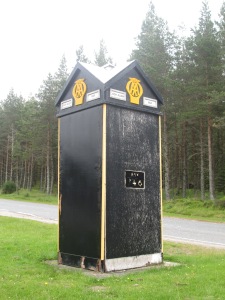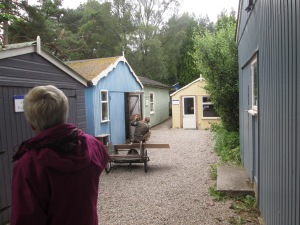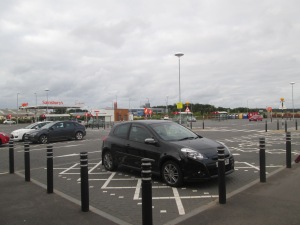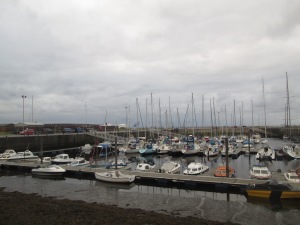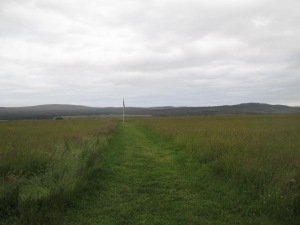‘It’s a crazy place, but in a good way…’ – Jackie, Forres.
The rain awakes me, pattering against the thin sheets of this tent perched on some nameless Highland hill. Little droplets form on the tent’s exterior, each one unique in outline, existing for a few moments, then rolling away.
It’s colder today, overcast and damp like an early winter morning. I listen for some time to the chirruping, whooping and cawing of the birds. The forest around me is densely packed with spindly tall trees, some rotten, some sporting a floral blue moss. This is wilder living, and now involves some wild toileting. As I take my trowel and bog roll to a more remote part of the woods, I spot the flight of a buzzard rising up through the trees.
The road from Grantown north is less hilly, but still surprises with its cascading and breathtaking panoramas as the road weaves through the glens. It’s also much more cultivated than further south, and instead of the wild patchwork greens and greys, I see lawns and attempts at modern farming. But the road remains rough-coat through jagged crags and rocks that line the rolling hills. I pause by one for a moment to catch my breath. Consider this rock. Write your name on it. Perhaps the mark would last twenty, fifty, or a hundred years, but soon after both you and your name will be forgotten, and this ancient and nameless crag will remain.
Signs indicate that this is the country of the Scottish play, Shakespeare’s Macbeth. Cawdor Castle stands alone in the distance, built long after the myths made around 11th century King Macbeth, and the empty stillness and chilly morning air suits the atmosphere of a menacing tragedy. Perhaps you’ll recall something from these haunted words of Lady Macbeth:
‘Glamis thou art, and Cawdor; and shalt be
What thou art promised. Yet do I fear thy nature;
It is too full o’ the milk of human kindness
To catch the nearest way: thou wouldst be great;
Art not without ambition; but without
The illness should attend it.’
The illness of desiring power at all costs, at the expense of paranoia, guilt, murder and madness. Enough could be learned from this today, if we human beings were ever capable of learning from history and myth’s mistakes, but alas. ‘I dare do all that may become a man; who dares do more is none.’ The vanity of selfish ambitions and the damages done.
My knuckled are blanched white by the cold, and I press on, passing by the Dava Way, a pretty diversionary old railway route that cuts an alternative trail to my route. There’s supposed to be a stunning viaduct at Divie, and indicates another reason to come back and further explore the Cairngorms. Just as I skipped Braemar on a tip, I was also advised by several people on the road to avoid Aviemore. ‘Tacky’, ‘crap’, ‘just ugly’ were the politer terms of description. The place has been ravaged by tourism and 1960s buildings. ‘They looked good for a year and then shite ever since’, is how Russell, a guy I meet later on the road, puts it. But ignore the tourist traps as I’ve done, and there are some thrilling things to discover.
Sadly the road from Grantown takes me out of the refuge of the Cairngorms. Military jets and rumbling army trucks appear above and about the road. The eerie pugilism of the road is matched by what I think is an eagle in the distance. Pretty soon the land becomes flat and low and I spot some ugly new housing developments. Welcome to Forres.
It’s a small town that’s expanded a little unevenly from a familiar style one street village into something of a small sprawl. Despite that, it’s a pleasant place. I spy a gargantuan Tesco and head there for some breakfast. Outside, as local school-children file into the store for fried chicken and factory sandwiches in immense numbers, I notice local people leaving their bikes completely unlocked by the stands. It’s quite a culture shock, and I’m keen to find out more.
Steve may be in a bad mood, but he’s quite negative about the place. ‘It’s ok, there’s some very nice walks outside.’ But the town? No, ‘there’s a lot of undesirables, bad types. Drugs.’ He seems pissed off and a little nervous in equal measure, but I’ve seen little evidence. He ends with a positive, and tells me that the town enjoys some passing tourism, and the following day will stage its own Highland games. I spot signs directing parties of pipe-players to the appropriate parking spot, and it reminds me of the Commonwealth Games baton signs I’ve seen over the last few days.
Despite a degree of justified cynicism by London-based critics about governments exploiting public festivities to sell off public land and boost house prices, local people I’ve met seem interested and invested in these occasions. They bring visitors, which helps the majority of people whose work depends on tourism, and they generate a kind of buzz and life to these otherwise quiet settlements.
I ask Jackie, another passer-by, about little Forres. Unlike Steve, Jackie was born here and thinks it a ‘good place’. She notes that it has expanded massively, with mixed effects.
‘It used to be small, it still feels safe, but … you used to be able to trust people, leave your backdoor open. Now the town has got much bigger.’ That said, she leaves her bike unlocked and laughs when I ask her why. The RAF and army bases nearby continue to bring people and probably contribute to the craziness she mentions, but there’s some more oddities further north.
There’s a path northbound from Forres to Findhorn by the sea, and I follow that, passing the ancient Suino’s stone, a 9th or 10th century slab detailing one of time’s forgotten battles, precious blood shed over the empty disputes of men. On my right, the road passes the army base at Kinloss with regular warnings about low-flying aircraft. It was once a larger NATO airfield but now seeming a little disused. A strange looking aircraft named after a royal flea sits gloomily in the airfield like a discarded toy. To my left are the wide mudflats of Findhorn bay, where an array of birds and invertebrates enjoy a somewhat undisturbed life on the Scottish coast. I take in the view then head just further to my next destination, the Findhorn Foundation.
I’d been intrigued by the description of this place in Mike Carter’s One Man and His Bike, a former hippie community that had now established itself as a unique centre of spiritual exploration. Whilst Mike throws himself into the activities of the centre, I approach with a degree of caution. On a noticeboard I take a look at what’s on.
First up, why not pay between £360 to £590 (depending on income, the hippie spirit!) for three days’ coaching to find your inner self. A man will use the age-old (trademark pending) Enneagram to unblock your inner channels. Less of a budget? Then join another Living Systems Design futurist on discovering those amazing evolutionary qualities in other living people, and learn how you too can emulate them!
‘Gaia loves our diversity and knows we can harmonise our perspectives to create a future that works for All!’
And for only £240-£450 for two days training in the evolution revolution, let’s hope Gaia also ensures we’ve got the reddies to pay for it. I was planning to stay over tonight at the community, but the sacred circle dancing, pan-eu-rhythmy at the field of dreams, which turns out to be a small settlement full of expensive eco-houses largely filled with rich and retired international visitors, the course in miracles group, and the general odd feeling puts me off. It feels like middle class escapism in playschool activities, dependent on vague and deluded ideas about the benevolence of nature. The courses and fees remind me of a Houston airport hotel conference room, where in exchange for just a few bucks you too can get rich, confident, or godly, as you please.
These are my first thoughts, but I realise I’m letting my prejudices make my mind up. I decide instead to give the place a chance, and I pay £8 for a two hour tour of the camp. Before it starts, I pop into the shop and consider the expensive crystals on display, the publications that warn of the great danger of electro-magnetic pollen, and a pack of expensive playing cards that promise to lead the buyer to Enlightenment. The tour begins, led by Caroline, who has lived and volunteered here over the course of several decades, and we’re joined by Yan, another visitor from Australia, and Marcus, a retired American who is learning how to become a camp tour guide.
The origins of Findhorn are even more peculiar than I’d expected. The community was first established by Peter and Eileen Caddy in 1962. Peter owned a hotel in the nearby village and enjoyed some success for a time, living there with his wife and three boys, until business went south and he lost his job. The family were penniless, and moved into a nearby caravan park, living in a freezing old tin box by a rubbish tip. In these years of poverty, Eileen began to have moments of inspiration, or ‘guidance’, often sat on the loo in the toilet block, which she would then write down. This guidance became increasingly instructive, informing her to build seven wooden bungalows. Whilst our guide describes this wide-eyed with a sincere belief in her visions, it strikes me as a small but canny way to make some money for the family.
This expands, and more people begin to join Eileen and Peter on their caravan site. They build wooden garages to live in and focus their spiritual explorations, and the pair are joined by another woman who claims to have visions from the Hindu devas. This guidance is deployed to … grow plants and vegetables, which, again with a degree of sincerity, our guide describes being agog at the sheer size of these miraculous cabbages.
The community grows, and word spreads, til finally the 1974 publication of The Magic of Findhorn by Paul Hawken puts the caravan park on the map as the spiritual community nonpareil. Dorothy had guidance from the devas to… talk to plants and vegetables, which grew amazingly well in the sand dunes. Soon the place becomes a magnet for wandering travellers, wealthy heiresses and frazzled big cheeses seeking some escape from the miserable materialism of the corporate rat-race. The Caddys deploy this influx of volunteers into the building of gardens and community structures, from a communal hall and kitchen to a vast universal hall for spiritual gatherings. Many volunteers become staff, living in cramped and old caravans, giving their time away in the search for higher spiritual awareness…
There are some beautiful gardens here, and despite what my account would suggest, this does feel like a content, relaxed and happy place. The sanctuaries built purely for inward reflection can be quite moving in the same way sitting inside an empty village church in the middle of nowhere also feels. As Caroline puts it,
‘I think we need to re-establish a connection with other forms of life. … We’re all part of one thing that expresses itself in many different ways. … I might think I don’t understand you, but we’re all part of the same stuff.’
Marcus echoes the sentiment. ‘I’ve come here to learn how to further that connection between head, and heart. And I’ve learned a lot.’
The community emphasises love and cooperation as its values, and it aims for a spiritual but not religious community for furthering inner awareness. The meditation of gardeners indicates the approach. Before starting, they hold hands in a circle. They focus awareness of themselves, then each other, then the activity at hand. They feel better able afterwards to concentrate and enjoy together the work at hand. Afterwards, they complete the same meditation circle and collectively agree to stop their energy. It’s about slowing down and taking greater notice of what’s around you.
But is this a suitable vehicle for it? The caravan park has been replaced by the eco-friendly settlements of seemingly wealthy people, mostly retired, who seek to come closer to the perceived magic of the place. There isn’t much to the place though except the buildings of the community and the classes they run. One can pay £20 to be a day guest and help cook and garden for the community, with meals but not accommodation included, and I’d considered this but shied away.
Caroline described how some people have a much higher spiritual awareness than others, and I couldn’t help finding this embarrassingly elitist. I didn’t get any impression that the foundation was trying to reach anyone outside it, such as the nearby Findhorn village itself, and even its back-story seemed dubious. It reminded me of the great sincerity of belief in spiritualism and metempsychosis among wealthy Victorians, of ghosts manifesting themselves among the ether in theatric séances that thrilled and excited, and rested on a good degree of ignorance and unhealthy credulousness that captivated highly intelligent minds, like W.B. Yeats, Henry Sigwick, Arthur Balfour and Alfred Russel Wallace. It thrives on underlying insecurities.
I leave the community with mixed thoughts (though I am cheered by spotting another Raleigh Pioneer outside one hut!), and decide to check out the village of Findhorn itself. I find a very small but pretty village, with a slightly rugged sandy beach and harbour. Heading back out, I make talk with Cath and Glen, and their granddaughter, who have lived in this village for some time. ‘It’s ok here’, a common opening gambit, but they tell me that they’re concerned about many things. The village’s chippie, Bunty, is about to close. It will be replaced with housing. The commercial fishing that once supplied Findhorn with an income has all gone, after wealthy landlords in the Highlands bought up all the rights to fish.
‘If you want to fish in this harbour here, it’ll cost you a thousand pounds or something, just for the day!’
They want to preserve stocks of salmon for themselves and for those rich tourists I’ve passed through the Cairngorms. I ask them if it’s related to English people settling in the area, as well as the aristocrats.
‘No, not just that. Some are Middle Eastern, South African. The landlord here is from South Africa. He inherited all this through a distant link to a cousin!’
This man has made many ugly and unwanted incursions of properties into village without consent. The local village association is planning to buy him out, and feel inspired by the stories of other small communities, like those on the Hebridean island of Eigg, who have similarly cooperated to buy out callous parasitic landlords like this.
I find all this deeply curious, but I have a more pointed question for them. ‘What do you make of the Findhorn foundation?’
Cath shakes her head. ‘We think they shouldn’t be allowed to use the name of the village. They have nothing to do with us.’ They dislike how the foundation has built up a large area but kept it totally separate from the village. The village association has tried to build a relationship with them, she thinks, but the foundation has made no effort in return. It reminds me that within the compound of the foundation, the only local information and B&Bs advertised were inside. The foundation’s farms produce more food than they can eat, but none is given away to a local community that would probably use it. Whilst the lived experience of those people at the foundation is real – they are largely happy, relaxed, and feel a sense of harmony with the world – it’s evident that this isn’t shared beyond.
I find the sentiment echoed further west, as I leave Findhorn and Forres and reach the old fishing town of Nairn. The main street of the town retains a traditional market-town style combination of heavy-bricked houses, a proud promenade of shops, if many underused, and an assortment of ugly places of worship and 1960s municipal buildings. I talk to an English couple out walking the dog.
‘Findhorn is a place where very rich people go who don’t know how to live their lives!’
Giles states this with a cheeky smile, and he and Lorraine tell me that tourism is now the main trade, much of it related to golf. I’m still unsure. It’s easy to judge others when we know little to nothing about them and their ways of life. The people I talk to who dismiss Findhorn haven’t actually been there, and don’t know anyone from the community. Although I’m a little dubious about it, it’s an unfortunate human trait to sneer at and disregard what we don’t know as therefore being without value. These people aren’t harming others, though perhaps are being harmed, financially at least.
I wonder if it relates to a more basic need for privacy, something which commentators like Kate Fox and Jeremy Paxman claim to be distinctly English. I don’t see privet hedges and front gardens indicating much other than a universal desire to have our own space, reflected in many diverse cultural forms. But the flipside of seeking privacy is to distrust and dislike others, something which I do think jars against the values of tolerance and liberalism which, to a fair degree, these isles boast a history of supporting.
‘Not a lot here today’, says Giles, but he points me to a book called Nairn in Darkness and Light, written by David Thompson over the 1940s and 50s which documents the imaginative world of local fishermen, a lost society. Wandering around Fishertown with its pretty Seaman’s library and depopulated pubs, it’s yet another glimpse at the wounds left behind when an industry, or should I say a way of life, is allowed to decline and disappear. A stoned-looking young guy outside the town’s Sainburys told me simply ‘it’s shit’. He lives here because it’s cheap. There’s ‘not many jobs’, but he doesn’t seem bothered either way. ‘There’s a few industrial estates’, he states hopefully, but I can’t gauge the relevance of his comment. He directs me to Uncle Bob’s, a cheap upstairs boozer overlooking the main drag.
I get my first pint of Tennents here! It’s the last Scottish beer left, and man is it good. I get talking to a local feller and the barmaid. The town is small and safe, they tell me. More locals clamber in and conversation flitters between holiday destinations, Barcelona and Las Vegas, and the dangers of the sun for fair skin! It’s a nice place to while away the time in friendly banter, but time flies, evening draws, and having abandoned Findhorn as my place of rest, what is Plan B?
I head west out of the town, passing by a large community arts centre. ‘Liam, you’re gay!’ shouts one of two girls left out of a group of lads’ antics. I spot the national cycle route 1 that old nemesis that I kept getting lost along in England, breaking parts of my bike, and my mind, following in vain. Ach, I make the mistake of following it again, eventually reaching a choice of a bridge going the wrong way or a tiny river path. No sign suggests which is best, and I have to retrace my path a mile or so.
This is it: no more cycle paths! I haven’t the time, map or mountain bike for their esoteric configurations. It makes me despair that so much money has been invested in cycle paths and campaigns that have resulted in, what? Organisations that claim that wearing cycle helmets makes no difference, celebrate when trucks are forced to remove signs that warn cyclists not to make ridiculously dangerous attempts to pass them, and which refuse to condone bad cycling practices. And the most ludicrous cycling lanes that expose the rider either to unnecessary danger or which last little more than a few metres. Cyclists across these isles deserve so much more.
In the meantime, I’m back on the A-roads where I can be sure I’ll reach a destination in one piece. The road west to Inverness is largely flat and downhill, a pleasant relief to a degree, but these flat and over-cultivated lowlands lack all the distinct features of the Cairngorms. Rain falls but it’s nae bother pal, and I detour off the track for another dive into forgotten histories.
Just shy of Culloden is Balloch, a village with a little shop and rude-sounding name in certain brogues. A local lad tells me that the battlefield here is little more than a moor but worth seeing. As he ties up a large pile of unwanted copies of Daily Record, he tells me that the village itself is quiet, populated with retired people, with others working in Inverness and Aberdeen. I bring laughter to his weary face when I point out that the shop still has some cans of Buckfast left after the recent Scotland-wide sellout! It’s a tempting brew, but I stock up on a couple of bottles of Innis & Gunn for the night ahead.
It’s a very steep ride to the battlefield, separate to the village that bears its name, but on the other side is a pretty forest and unlikely tourist-targeted Culloden bar. Though the visitor centre is closed, a footpath can take you into the great expanse of field where the final pitched battle on these isles took place. Rabbits dart about the entrance and flee with the wagtails and sparrows when I approach. I am the only one here, and in the late evening there is a lonely emptiness to the place, the heather moors, the red and blue flags of each side on that awful 16th August 1746 struggle, and stones commemorating the slaughtered Highland clans.
So what happened at Culloden? It’s another historic turning point in Scotland’s troubled history which has been thoughtfully erased from taught history in schools, and before I set off, I’d’ve struggled to say whether Culloden, Bannockburn, Flodden Field or Stirling bridge were fought in 8th, 12th, 15th or 18th century. But unlike the wars for independence led by William Wallace and Robert the Bruce, the battle of Culloden isn’t quite a struggle of Scotsman and against Englishman. It was the final battle in the abortive Jacobite uprising, a series of uprisings led across Great Britain and Ireland to restore the exiled Stuart monarchy. Its first incarnation was between 1685-89, when the Catholic monarch James II reigned and was eventually overthrown by William of Orange, a Protestant from the Netherlands, between 1688 and 1689. James continues the rebellion in Ireland but by 1701 it has been effectively extinguished. It’s from this first struggle that much of Northern Ireland’s chequered sectarian struggles, like the ‘Orange orders’ fighting Catholic Irishmen loyal to James, emanates.
There are more Jacobite uprisings, one in 1715 with support from various parts of England and Scotland, but the struggle collapses after incoherent leadership. It’s the final uprising led by Bonnie Prince Charlie, or Charles Edward Stuart, that’s most relevant. Highland clans had been warring amongst themselves, and some feared the rising influence of the Presbyterian Campbells of Argyle. They invited Charles to gather up some French soldiers and land in the Hebrides for a new uprising. The timing was perfect: most of the English army was overseas fighting the French. They lead an uprising and make it all the way to Derby, but turn back after it becomes clear that neither the English nor the French are willing to help them. They flee back to Falkirk, where they defeat the now-Hanoverian monarchy’s British army, but it’s their last stand at Culloden which leads to disaster, as the Highland clans are decimated by a superior army just east of Inverness.
The Bonny Prince flees the country dressed as a milk-maid, but for the surviving clans life becomes truly desperate. All forms of Highland dress like tartan and kilts become outlawed (and hence, culture), and the feudal power of chiefs over subjects is nullified by law. After 1746 many chiefs would gradually become entrepreneurial landowners. With no obligation to their former clans, they turned to profit, sheep-farming. A century later, most of the villages of the Highlands would either be burnt down or abandoned.
The doomed words of the tragic, power-drunk Macbeth come to mind: ‘I dare do all that may become a man; who dares do more is none.’
Rain falls heavily afterwards, and I struggle to make out the road to Inverness. It’s all downhill which is easy enough. I ask a local man, Sandy, for directions to Inverness castle. There’s a hostel nearby where for £15 I can get a shower, plug to charge my phone, and waterproof place to sleep. Despite the rain, Sandy pauses and fields my annoying questions.
‘It’s a small town aye, but increasing rapidly. A new university will open next year! I’m not sure if it’s such a good thing. It’s getting big very quickly, people from Glasgow, people from London, are moving up here to escape those places. It’s the centre to the Highlands still. What can you do?’ He shrugs, as do I.
The hostel is perched up a steep hill, and inside are cheerful European and Chinese backpackers landed in this unlikely part. Philip spots my bike bag and introduces me to his friend Lucas, and the pair of young fellers have come here from Switzerland. They’re both travelling around the wilds of Scotland on a tandem bike! On a map they trace their route around Inverness, Beuley, Ullapool, Lewis, Skye and elsewhere, and we trade our stories of disaster and delight on the road in the same way that school-boys compare scabs.
I drink my beers and devour a heap of rice, beans and cheese. I overhear an arrogant young German debating with an arrogant young American about nature vs nurture. Both are too cocksure to understand the other’s position and I realise that bored females are caught up in their company. Later the German jokes with another about the stupidity of Americans, and I sigh inside. I talk to Danni who has found her way to Inverness a little by accident, travelling here and there, making friends in this hostel, and then, in that wonderful way that life events are so often cast in, takes the opportunity of a local job to move here.
Why? Why not? These great life events each occur by accident. What can we do to shape them? What leads us here? What led me here, to Inverness, on a cold wet night? Or my mum, and my dad, to London? Or to you, where you are now? Chances are, serendipity, luck, opportunity, restlessness and a certain unquantifiable degree of randomness are at work. Plans? They’re not as much use as I’d thought.



















